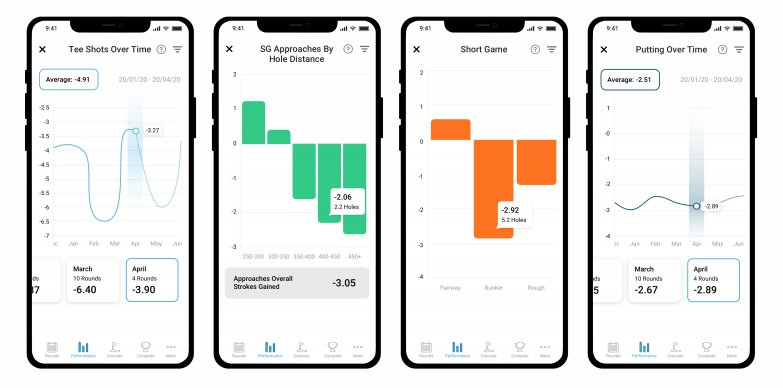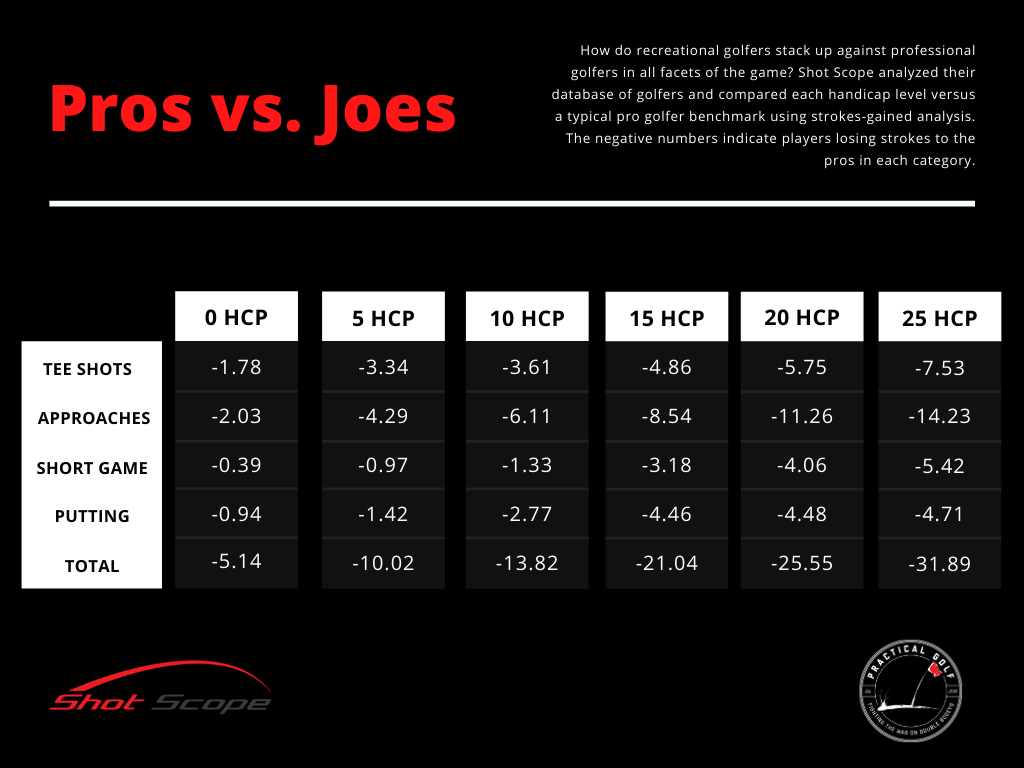
We all know that tour players are light years better than recreational golfers at every part of the game. But for a long time, it was hard to quantify the differences in performance when it came to tee shots, approach shots, wedge play and putting. With the advent of strokes gained analysis and plenty of data collected by shot tracking companies at the amateur level, we now have plenty of reference points to make this comparison.
This article will share some data from Shot Scope showing what parts of the game tour players truly separate themselves from weekend warriors. While it's fun to see this comparison, I also want you to learn more about what it takes to lower your scores and what you can do to track your progress along the way effectively. Also, stay tuned for a special offer.
Why Strokes Gained Is More Informative Than Traditional Stats
Before we get into the "Pros vs. Joes" comparison, I quickly want to summarize why traditional golf stats are less prescriptive in telling players where they need to improve their game versus strokes gained analysis. This can be a complex topic, and I plan to go into greater detail in a separate post, but here is a quick summary for those who are not too familiar with the concept.
Where Traditional Statistics Fall Short
Tracking your fairways hit, greens in regulation, putts per round, and scrambling percentage has value. But these statistics do not paint the complete picture of your performance. Especially when you are looking at which parts of your game need the most work relative to golfers at the scoring level you are looking to achieve.
Typically, I pick on fairways hit as one of the most misleading statistics (putts per round is up there too).
Let's take two golfers who average 50% fairways each round. At face value, one could assume they have similar ability off the tee. While that is possible, it is not enough detail to truly know which golfer is performing better. Here is a theoretical circumstance to illustrate how that is possible.
Golfer A averages 230 yards per drive, whereas Golfer B averages 275 yards per drive. Additionally, when player A misses fairways, they typically end up in 3-4 recovery situations (i.e., in the trees) or incur penalty shots per round. Conversely, Golfer B seldom ends up in a penalty area off the tee and only ends up in the trees 1-2 times per round.
Player B is a far superior driver of the golf ball because they hit it farther and avoid trouble off the tee more often than player A. However, fairways hit can't take into account all of these variables. It is not enough information. We now know that how far you hit the ball combined with where your ball ends up when it does miss the fairway has an incredible amount of influence on a golfer's ability to score.
This is exactly why Jim Furyk can still be one of the leaders on the PGA Tour in fairway percentage off the tee, but using strokes gained, we know he is not one of the best drivers because he can't hit it as far as the competition (who are more accurate than we first assumed).
I could go on into putts per round, but let's leave it there. Overall, traditional stats are a starting point, but the truth is a bit more complicated.
Strokes Gained Takes Most Everything Into Account
When Mark Broadie first introduced Strokes Gained analysis, it was a revelation about how golfers separate themselves from one another in each part of golf (tee shots, approach shots, wedge play, putting).
The equation itself and explanation of how strokes gained works can confuse people sometimes. But the good news is you don't really need to be able to calculate it yourself. There are plenty of apps and services that do this for golfers now and give them a top-level view of where they are losing or gaining strokes in each part of the game relative to other golfers. Some examples are Shot Metrics, Arccos, DECADE, and now Shot Scope.

If you do want to take a deeper dive into strokes gained, I recommend reading this article from Shot Scope. Also, Every Shot Counts by Mark Broadie is a wonderful book that I recommend to all golfers to get a fundamental understanding of how golfers really generate their scores.
This quick video from Scott Fawcett from DECADE gives a nice, quick explanation as well:
https://www.youtube.com/watch?v=YBtEW8oS6q4
All in all, strokes gained is the easiest way to track your true performance in each part of golf relative to other golfers.
For example, let's say you were a 10 handicap looking to get down to a 5 handicap level. Seeing where you are gaining or losing strokes to a 5 hcp in each part of the game will give you a quick explanation of where you need to improve.
You might find that you are gaining strokes off the tee because you hit it relatively farther and keep it in play more often than a typical 5 handicap. Conversely, you could lose strokes on approach shots because you are missing too many greens, and when you do, you are in tough positions on the golf course.
At that point, if you are using a game tracking system like Shot Scope or Arccos, you could take a deeper dive into your approach statistics to find out where the problem lies. It could be you are missing greens because you don't take enough club. Or perhaps being too aggressive with your target leads you to short-side yourself on one side of the green.
Either way, using strokes gained is a much more efficient process at getting to the truth on where you need to improve. PGA Tour players have benefited for years because Shot Link tracks every shot they hit with precision. Now that game tracking platforms have become more popular, this same advantage is available to recreational golfers. We have enough data on where golfers are hitting shots on the course to serve as reference points for strokes gained calculations.
How Do Normal Golfers Perform Versus Tour Players?
If you're a Practical Golf reader, you know that I don't think it's a good idea for weekend warriors to use PGA Tour players as inspiration for their game. But I thought it would be an interesting, fun exercise to see where golfers of various handicap levels lose the most strokes in their game relative to the pros.
In 2021, Shot Scope officially added strokes gained data to their stats portal. The release will have three phases throughout the first six months of this year. Phase 1 will include strokes gained data vs. tour players, which is available now. Phase 2 will take a deeper dive into each statistic. Most importantly, Phase 3 (scheduled for June) will allow golfers to benchmark themselves against different handicap levels.

I asked Shot Scope to run some numbers for me with all this new data and see where golfers at various handicap levels are losing strokes to tour players.
While it won't come as a surprise that regular golfers can't outperform tour players at just about anything, I was interested to see where the biggest differences occurred.
Two of the biggest revelations from Every Shot Counts and Mark Broadie's research were the following:
- Putting is not as influential in scoring differential as we first assumed. Broadie assigned 15% importance to putting in determining any player's score. It turns out putting is much harder than we all thought, and it's harder for golfers to separate themselves from one another with the flat stick.
- The long game accounts for roughly 2/3 of scoring differential. In other words, shots outside of 100 yards (tee shots and approach shots) are the biggest determining factor in why one golfer scores better than another. Broadie concluded that approach shots are where most scoring occurs.
The Data
So how did that hold up in the Shot Scope data? Have a look below:

I'd say it held up pretty well! As you would expect, in aggregate, golfers of all handicap levels are losing strokes to tour players. Of course, singular golfers might gain strokes in one category with exceptional play, but on the whole, there's a reason why pros make the big bucks.
As you can see, the clearest trend is that approach shots are where golfers lose the most strokes. The gap seems to widen as handicaps get higher as well.
Tee shots take second place. The difference isn't as extreme as approach shots, but they are still very significant.
Putting does edge out the short game in just about every handicap level.
Overall, when you combine tee shots and approach shots and divide them by the total strokes lost, Broadie's ratios hold up - even more than the 2/3 he spoke about at certain handicap levels.
One thing to note is that Shot Scope does consider anything outside of 50 yards as an approach shot. Some apps will use the cutoff at 100 yards. Overall, I think this does skew these numbers a little more towards approach shots. But I don't think it changes the general takeaways I will cover in the next section.
Some Bigger Takeaways
I wanted to show this data to reinforce some of the key concepts I discuss on Practical Golf. And to be honest with you, I got a lot of this wrong and even resisted this information when it first became available to me years ago. But as I discussed in my long driver experiment, I'm not opposed to changing my mind when new information becomes available!
The Biggest Scoring Breakthroughs Come With Approach Shots and Tee Shots
If a golfer is looking to have a breakthrough in their game and shoot their lowest scores - I usually tell them two things:
- Build your game around hitting more greens in regulation. I still believe this traditional statistic has the most value. But what it really means is that I want you to become a better iron player and smarter with your targets.
- Become more efficient with your driver: keep it in play (it's not fairway or bust), and employ reasonable methods to increase your distance. You can listen to our latest episode of the Sweet Spot Podcast to learn more about this concept.
Yes, that sounds incredibly simple, and it's not going to be easy. It will likely require more practice time and perhaps swing lessons, but the data is unequivocal on this. Tee shots and approach shots are going to make the biggest difference in your scoring.
Short Game Is Still Important, But Perhaps More of a Refinement
The last thing I want to do is make it seem like your wedge play and putting are not important. They're still very important for scoring!!!
I see these as quick wins, but they have a ceiling.
Generally speaking, if golfers paid more attention to their wedge play and putting, they can experience a faster reduction in their scores. However, that progress will eventually get "tapped out" once an adequate proficiency level is achieved.
So if you are someone who loses a lot of strokes around the greens with chunks, skulls, and three putts, that can be low-hanging fruit for a handicap reduction. If you were tracking your stats using strokes gained, this would become very clear.
And, of course, there is the time element. If you only have a limited amount of time to practice, I often view the short game as a better short-term investment.
We Are All Unique Snowflakes
One of my greatest "handicaps" as your virtual coach is that I cannot account for each of your situations. You all have varying skill levels, time commitments, and different goals for your golf game. Some of you are looking to break 100, and others are looking to take that final step of becoming a scratch golfer. That's the beauty of this game!
If you do want to become a better golfer and make the process more efficient, then I believe a concept like strokes gained and stat-tracking, in general, can be invaluable.
Despite what I discussed in this article at a generic level, each of you likely has your own unique set of circumstances. Some of these trends might not hold up for you, but you wouldn't know unless you tracked and had the right analysis done.
To that end, we are running a pre-season special on Shot Scope's V3 performance tracking system where you can save $40 (you can read my review here). If you want to take advantage of the new strokes gained feature, you will have to start entering your spring rounds before the rollout is complete this June. I've paid attention to this market a lot over the years and still believe they offer the best value since you get a GPS watch, 16 sensors that attach to your grips for on-course tracking, and access to their robust stat-tracking portal at no ongoing cost.
Additionally, some of the other products and apps I've mentioned in this article can also show strokes-gained analysis.
Here are some more articles I've written using Shot Scope's data that I think you'll find interesting:
30 Million Shots Analyzed: Here Are 4 Mistakes Holding Golfers Back
How Does Performance Change By Handicap Level?
Driver vs. 3-Wood Off the Tee: What's the Right Decision?
We care about the protection of your data Read our Privacy Policy